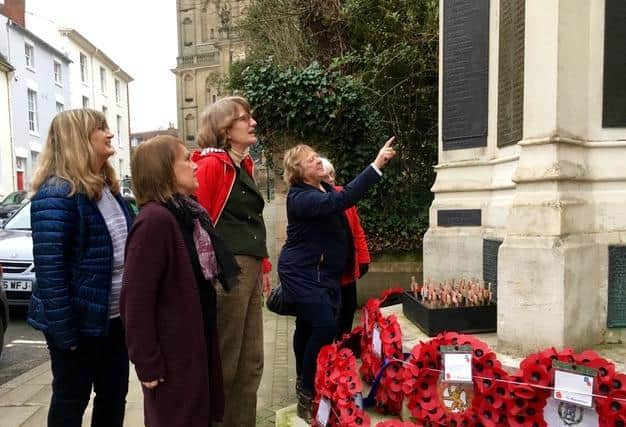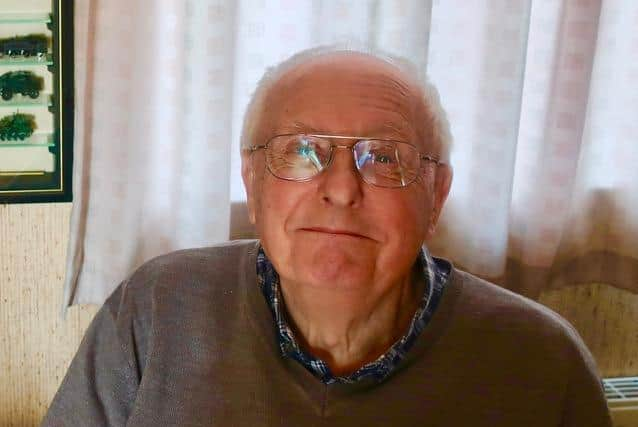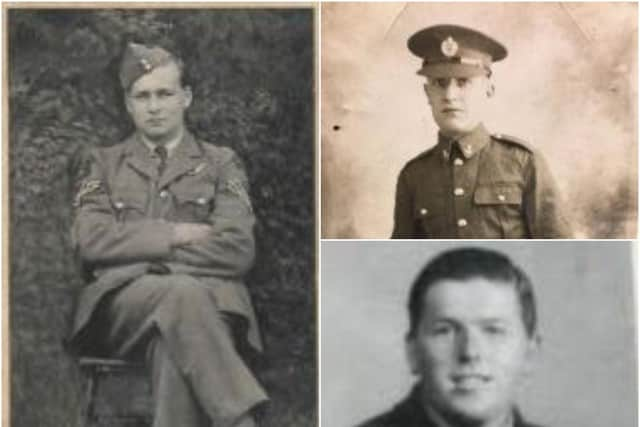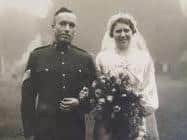Here's more stories behind the names of the WW2 soldiers on Warwick's war memorial
and live on Freeview channel 276
Unlocking Warwick is researching the stories behind the names of those who died in the Second World War on the Church Street memorial in the town.
They are asking people to get in touch with information about those who died, and also if they have memories of life in Warwick during the war.
Advertisement
Hide AdAdvertisement
Hide AdReaders of The Courier have responded well to the appeal launched on VE Day by Unlocking Warwick, Warwick Town Council volunteers, for photos and information about the local men who died in the Second World War.


The Secretary of Unlocking Warwick, Rick Thompson, said: “Already we have been contacted by several local families who lost a relative in the Second World War, and we are starting to build up portraits and stories of all the 112 Warwick men commemorated on the Church Street memorial, making them available on our special website www.warwickwarmemorial.org.uk
“We have also received a wonderfully vivid account of his childhood in Warwick from Peter Stocker, who was five when war broke out, living in Cape Road.
“He was clearly a bit of a scamp, swimming with his school-friends in a huge temporary water tank erected in The Butts in case the fire brigade’s water supplies would be put out of action by bombing, and riding in the rail wagons bringing coal from the canal to the gas works.
Advertisement
Hide AdAdvertisement
Hide Ad“He and his friends also had a close encounter with a German bomber that flew low overhead along Myton Road heading for the Leamington factories.


“He remembers the rear gunner waving at him.
“One of his friends loosed off a ball-bearing from his catapult. It missed.
“You can see Peter’s full account under ‘Personal Memories’ in the WW2 section of the website.
“If you know of anyone else who can remember life in Warwick during the war, please ask them to get in touch with Christine Shaw, Leader of the War Memorial Project at: info@warwickwar memorial.org.uk


Warwick School Old Boys who died in WW2
Advertisement
Hide AdAdvertisement
Hide AdThe old boys from Warwick School – the Warwickians – suffered a disproportionate number of casualties in WW2, partly because many became officers who led from the front.
And others joined the RAF which suffered a very high casualty rate. Sixty percent of Bomber Command were killed, wounded or taken prisoner.
More than sixty men who had attended the school died in the war.


Seven of them were local men who are commemorated on the war memorial plaques:
Peter Joynson
Advertisement
Hide AdAdvertisement
Hide AdPeter lived with his parents and two young brothers at 62 Emscote Road. At Warwick School he was a keen sportsman, excelling at shooting, rugby and boxing. He was killed in action in France in May 1940 as the British Expeditionary Force was retreating towards Dunkirk. He was just 19 years old.
Ronald ‘Ron’ Guy Horne
Ronald Horne, known as Ron, was born in Warwick in 1920, the youngest of five children. His father was a sewage disposal engineer and they lived at The Pumping Station on Longbridge Road.
He was employed as an architect in Stratford before he enlisted in the RAF, flying Armstrong Whitworth Whitely planes with Bomber Command.
His great nephew, Chris Horne, told Unlocking Warwick, “My dear late Grandparents, Jack and Dorothy Horne, often talked of Grandpa’s brother Ron (Ronald Guy Horne) who served in the Second World War in the RAF and according to them was lost on a mission over the Bay of Biscay.”
John Randall
Advertisement
Hide AdAdvertisement
Hide AdJohn Randall who lived at 28 Chapel Street is also commemorated on the memorial, though he did not die abroad.
At the age of just eighteen he was an ARP Warden who according to newspaper reports ‘had served with distinction during the Coventry blitz’.
In 1941 while on a training exercise, his motorbike was hit by an army lorry on the Banbury Road.
He was the only child of the Randalls, so that branch of the family has died out. John’s grave in Warwick cemetery is now overgrown.
Herbert and George Measures
Advertisement
Hide AdAdvertisement
Hide AdThe Measures brothers lived with their family at 63 Emscote Road. At Warwick School Herbert won a scholarship to Oxford and became a ‘tropical horticulturalist’ working in the West Indies and Africa.
He joined the King’s African Rifles, and was killed in what is now Ethiopia in 1941.
The following year his brother George also died in the war.
He had joined the Royal Navy Volunteer Reserve and was serving on the aircraft carrier, HMS Indomitable when it was part of a huge convoy attempting to liberate the besiged island of Malta.
Advertisement
Hide AdAdvertisement
Hide AdThe ship came under attack from submarines and Italian aircraft in the Mediterranean sustaining considerable damage.
During the action, George was lost at sea.
Both the brothers are commemorated on the Warwick war memorial.
Thomas Wesson
Thomas Wesson loved flying. He had even been a wing-walker for a while with a flying circus. So it was no surprise that he joined the RAF and became a flying instructor.
In 1941 he was killed in an aircraft accident at Booker Airfield in Buckinghamshire, and is buried in Warwick cemetery.
Other Stories:
Advertisement
Hide AdAdvertisement
Hide AdDennis Lloyd – died at El Alamein. Dennis was one of seven children born to Evan and Edith Lloyd who lived in Clarence Street, Leamington. In 1935, Dennis married a Warwick woman, Violet Parsons, and they made their home at 6 Linen Street. Violet gave birth to two sons there.
During the war, Dennis served first with the Royal Engineers, then with the Military Police during the El Alamein campaign led by Field Marshal Montgomery.
Dennis was killed in October 1942 and is buried at the El Alamein War Cemetery in Egypt.
His younger brother Derek joined the Navy, and was killed at Gibraltar in September 1943.
Advertisement
Hide AdAdvertisement
Hide AdBoth Dennis and Derek are commemorated on Leamington’s Memorial.
Fred Green – Took his Wife to India. Fred Green, the son of a local plumber, was a professional soldier with the Royal Warwickshire Regiment.
In 1936 he married Nellie Smith at St Paul’s Church in Warwick.
War broke out three years later and when Sgt Green was despatched to India in 1941, Nellie (or Nel) travelled with him.
Advertisement
Hide AdAdvertisement
Hide AdIn October 1941, they had a daughter, Pauline. But six months later, whether from injury or illness, Fred had been brought back to England and he died in Warwick at the age of 41.
He is buried in the Commonwealth War graves section of St Michael’s Churchyard in Budbrooke.
Fred’s younger brother, Albert, serving with the Royal Army Ordinance Corps, was captured by the Japanese in Singapore and was a prisoner at Hakodate POW camp until liberated three and a half years later..